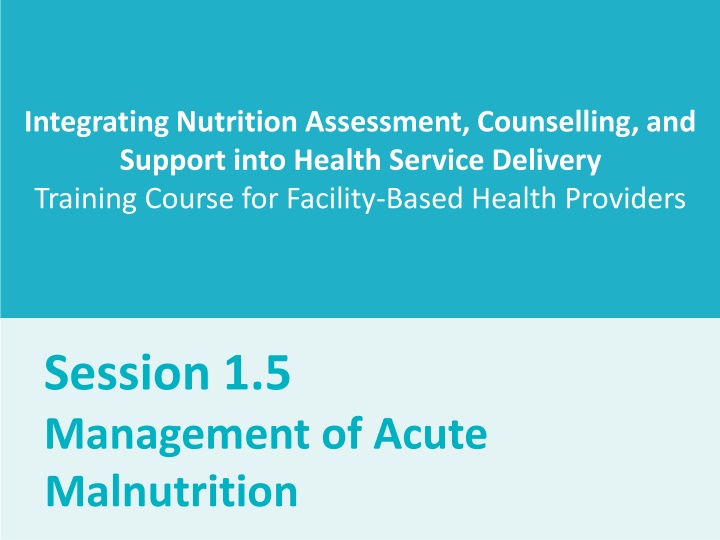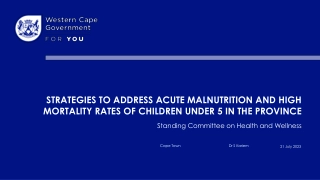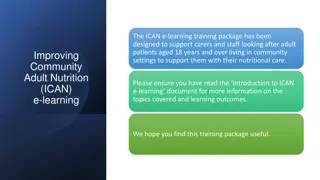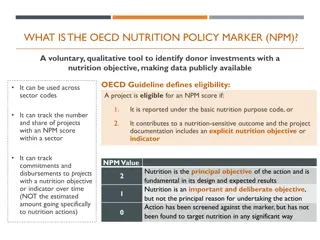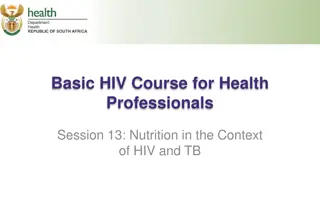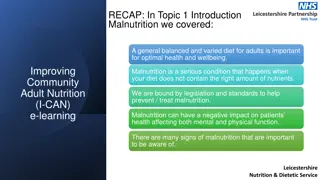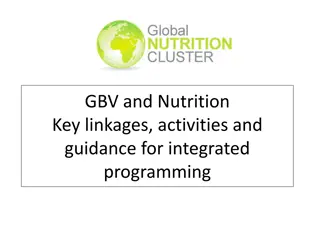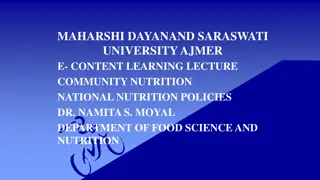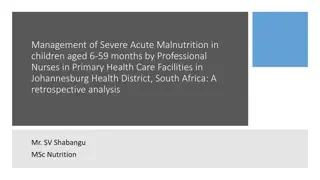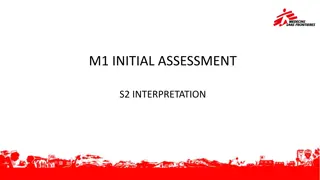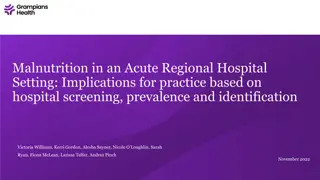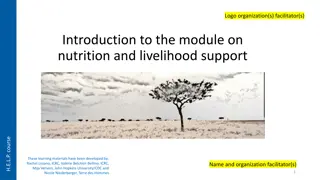Integrating Nutrition Assessment and Support for Health Providers: Session on Acute Malnutrition Management
This training session focuses on the management of acute malnutrition through inpatient and outpatient therapeutic care, supplementary feeding programs, and community linkage for early intervention. It outlines the types of therapeutic foods used in nutrition care, discharge criteria for outpatient care, and advantages of integrated nutrition services. Participants will gain knowledge on protocols for comprehensive outpatient therapeutic care and common types of care offered in Uganda.
Download Presentation

Please find below an Image/Link to download the presentation.
The content on the website is provided AS IS for your information and personal use only. It may not be sold, licensed, or shared on other websites without obtaining consent from the author.If you encounter any issues during the download, it is possible that the publisher has removed the file from their server.
You are allowed to download the files provided on this website for personal or commercial use, subject to the condition that they are used lawfully. All files are the property of their respective owners.
The content on the website is provided AS IS for your information and personal use only. It may not be sold, licensed, or shared on other websites without obtaining consent from the author.
E N D
Presentation Transcript
Integrating Nutrition Assessment, Counselling, and Support into Health Service Delivery Training Course for Facility-Based Health Providers Session 1.5 Management of Acute Malnutrition
Session Objectives By the end of the session, participants will be able to: Describe common types of therapeutic and supplementary foods used in nutrition care Describe concepts and types of therapeutic care Discuss the protocols of comprehensive outpatient therapeutic care (OTC) Describe the discharge criteria/outcomes of OTC Integrating Nutrition Assessment, Counselling, and Support into Health Service Delivery 2
Management of Acute Malnutrition Integrated management of acute malnutrition (IMAM) has four components: 1. Inpatient therapeutic care (ITC) for patients with: Acute malnutrition and medical complications Infants < 6 months of age with visible signs of acute malnutrition or whom have failed to feed 2. Outpatient therapeutic care (OTC) for patients with acute malnutrition and no medical complications 3. Supplementary feeding program (SFP), used in difficult circumstances 4. Community linkage for early identification, referral, and follow-up of acutely malnourished cases Integrating Nutrition Assessment, Counselling, and Support into Health Service Delivery 3
Advantages Reduces: o Unnecessary exposure to additional infection risks in health facilities o Time caregiver spends away from home and family o Disruption of the caregiver s economic activities o Congestion in the health facility and health worker workload o Health facility costs, allowing reallocation of resources to other priorities Contributes to early diagnosis of HIV infection for better care and outcome Integrating Nutrition Assessment, Counselling, and Support into Health Service Delivery 5
Brainstorm What are therapeutic foods? What are commonly used therapeutic foods in Uganda? What are supplementary foods? What are commonly used therapeutic foods in Uganda? Integrating Nutrition Assessment, Counselling, and Support into Health Service Delivery 6
Therapeutic Foods Specially formulated for specific, nutritional, therapeutic purposes Used to feed children with SAM or to supplement the diets of people with special nutrition requirements Provided according to prescribed doses Include milk-based diets (F-75 and F-100) and ready- to-use therapeutic food (RUTF) Integrating Nutrition Assessment, Counselling, and Support into Health Service Delivery 7
Therapeutic Foods: Formula 75 (F-75), Formula 100 (F-100) Milk-based powdered mixes that are reconstituted with water Contain powdered milk, sugar, and other ingredients Provide an easily absorbed and medically appropriate amount of energy, carbohydrates, protein, fat, and essential micronutrients Formula 75 (F-75) Used in phase 1 of ITC (stabilization) Contains 75 kcal/100 ml and 0.9 g protein/100 ml Prescribed and fed every 2 to 3 hours for 2-7 days from admission Formula 100 (F-100) Higher in energy and protein; contains 100 kcal/100 ml, 2.9 g protein/100 ml Used in phase 2 of ITC (rehabilitation), given in increasing amounts with increased appetite Designed to promote weight gain Child transitions from F-75 to F-100 gradually Integrating Nutrition Assessment, Counselling, and Support into Health Service Delivery 8
Therapeutic Foods: RUTF Lipid-based, energy-dense, mineral/vitamin-enriched food with a formulation equivalent to F-100 (key difference: RUTF has iron) Specifically designed to treat SAM in OTC or phase 2 of ITC Most common RUTF is a paste made from peanuts, milk powder, oil, sugar, and a mineral/vitamin and protein mix Integrating Nutrition Assessment, Counselling, and Support into Health Service Delivery 9
Therapeutic Foods: Benefits of RUTF Is prescribed based on the child s weight, making it easy to calculate the quantity to distribute Has a long shelf life, even without refrigeration Resists bacterial growth Does not need to be diluted with water, reducing risk of contamination No preparation or cooking is necessary; can be eaten directly from the sachet Can be fed to child at home, allowing for OTC for SAM Has appropriate nutrient mix to promote rehabilitation of children with SAM Integrating Nutrition Assessment, Counselling, and Support into Health Service Delivery 10
Supplementary Foods for Managing MAM Fortified blended food (FBF) Fortified blended foods (FBF): blends of partially precooked and milled cereals, soya, beans, and/or pulses fortified with micronutrients (vitamins and minerals) Usually mixed with water and/or oil and cooked as a porridge Used to prevent and address nutritional deficiencies among vulnerable populations Includes corn-soya blend (CSB), super cereal (CSB+), and super cereal plus (CSB++) Integrating Nutrition Assessment, Counselling, and Support into Health Service Delivery 11
Supplementary Foods: Benefits of FBF Can be prepared like other foods from home Can be used for treatment of moderate malnutrition in the family/household Many moderately malnourished adult clients prefer CSB to RUTF Integrating Nutrition Assessment, Counselling, and Support into Health Service Delivery 12
Inpatient Therapeutic Care (ITC) For management of patients with acute malnutrition (SAM or MAM) and medical complications. Purpose: to concurrently treat medical complications while providing nutrition therapy Length of stay varies from 1 to 6 weeks, depending on: Severity Response to treatment Time taken to regain appetite Management provided in phases Integrating Nutrition Assessment, Counselling, and Support into Health Service Delivery 13
ITC (continued) Phase I (stabilization phase) Takes 2-7 days Medical conditions/complications managed; broad spectrum antibiotics given to treat/prevent infections Clinical monitoring of progress F-75 is prescribed and fed every 2-3 hours by mouth or through feeding tube Clients gradually transition from F-75 to either F-100 or RUTF Integrating Nutrition Assessment, Counselling, and Support into Health Service Delivery 14
ITC (continued) Phase II (Rehabilitation phase) Takes 2 6 weeks. Patients receive F-100 and gradually transition to RUTF and/or a normal local diet. Patient may be transferred to OTC once medical complications are resolving, and he/she is alert, clinically well, and has good appetite. Integrating Nutrition Assessment, Counselling, and Support into Health Service Delivery 15
Outpatient Therapeutic Care (OTC) OTC provides home-based treatment and rehabilitation for clients with SAM with no medical complications and good appetite Based on three key factors: o Absence of medical complication o Availability of RUTF o Availability of functional community structures Integrating Nutrition Assessment, Counselling, and Support into Health Service Delivery 16
OTC: Integration into Health Care Services Enabling factors: Human resource (trained staff) Equipment and and supplies IEC materials: Counselling aids and other job aids (infant and young child feeding, nutrition care and support) Strengthened capacity for service delivery, monitoring, evaluation (M&E), and reporting o Staff trained, supervised, and mentored o Availability of M&E tools and forms o Quality improvement Linkages between facilities and various community services (bidirectional referral systems) Integrating Nutrition Assessment, Counselling, and Support into Health Service Delivery 17
OTC: Referrals and admission criteria Referrals from/by: Wards, counselling units, immunization points ITC (when a client s condition improves) Community volunteers or other community structures (village health teams, community-based organizations, community development officers) Self referrals/caregivers Admission criteria (Table 1.5.2 Reference Manual) Integrating Nutrition Assessment, Counselling, and Support into Health Service Delivery 18
Management Protocol for OTC Integrating Nutrition Assessment, Counselling, and Support into Health Service Delivery 19
Quantities of RUTF for Appetite Test RUTF Weight of client (kg) < 4 kg 4 6.9 kg 7 9.9 kg 10 14.9 kg 15 29 kg > 30 kg Sachets to sachet > sachet sachet to sachet to 1 sachet > 1 sachet Integrating Nutrition Assessment, Counselling, and Support into Health Service Delivery 20
Protocol for RUTF in OTC Screening for acute malnutrition Weight (kg)/age Sachets/day Sachets/week 3.0-3.4 1.25 9 SAM with no medical complication/MAM (child) 3.5-3.9 1.5 11 4.0-5.4 2 14 5.5-6.9 2.5 18 7.0-8.4 3 21 8.5-9.4 3.5 25 9.5-10.4 4 28 Start on RUTF 10.5-11.9 4.5 32 Passed appetite test > 12.0 5 35 Review patient in 1-2 weeks to assess need for ongoing treatment for up to 4 months 14 yrs and older 6 42 EXIT if clinically well and WFH > -2 z-score (children < 5) or 10% weight gain (adults) 21 Integrating Nutrition Assessment, Counselling, and Support into Health Service Delivery
Medical Treatment Antibiotics Routine first line: Amoxicillin PCP prophylaxis For HIV positive/exposed: cotrimoxazole (Septrin) Antifungal treatment for oral thrush Antifungal: Nystatin suspension or Fluconazole Vitamin A Preventive dose in certain situations; not provided to clients given RUTF (see IMAM guidelines for more information) Note: If signs of vitamin A deficiency, refer to ITC, where they will receive treatment Malaria testing and treatment Clients should be tested upon admission or during clinical exam; treat if blood test is positive, according to protocol Deworming (Antihelminths) Mebendazole or Albendazole, at second visit for clients > 1 year Measles Check vaccination card upon admission; vaccinate children 9-59 months of age who cannot show proof of vaccination Integrating Nutrition Assessment, Counselling, and Support into Health Service Delivery 22
Follow-Up Client should return every 2 weeks or synchronize with other routine appointments: Nutritional assessment: weigh, measure MUAC, and check for oedema Physical examination Appetite test Record/update information on client card Counselling/education on relevant essential nutrition action Medicine and RUTF Integrating Nutrition Assessment, Counselling, and Support into Health Service Delivery 23
Transferring to ITC Transfer to ITC if these symptoms and signs are observed during follow-up calls: Bilateral pitting oedema grade +++ or worsening oedema Severely reduced appetite Coughing High fever Diarrhoea Anaemia or pallor Extreme weakness or convulsions Abnormally cold extremities Lack of alertness Integrating Nutrition Assessment, Counselling, and Support into Health Service Delivery 24
Failure to Respond For clients who have not responded by third visit, possible causes may include: o Sharing RUTF or not consuming: Counselling o Absenteeism: Home visits/counselling o Undiagnosed illnesses (HIV, TB, SCD) o Medical issues (unresolved infection, malabsorption) NOTE: Patients with any of the above should be counselled and/or appropriately referred for further investigation Integrating Nutrition Assessment, Counselling, and Support into Health Service Delivery 25
Role of Community Resource Persons (CRP) CRP : Identify and refer patients with malnutrition for further investigations Provide counselling on proper nutrition and feeding practices Follow up patients on care who have defaulted from the OTC and encourage them to return Promote healthy practices in the community Link patients in care to available livelihood programs Integrating Nutrition Assessment, Counselling, and Support into Health Service Delivery 26
Exit (Discharge) Criteria: Cured MUST APPLY TO ALL CASES Age group Discharge criteria 6 months to < 5 years MUAC 12.5 cm or WFH/L -2 z-score (use same indicator used at admission) No oedema for at least 2 weeks and clinically well and alert 5 to < 10 years BMI for age -2 z-score or MUAC 14.5 cm 10 to < 15 years BMI for age -2 z-score or or MUAC 18.5 cm No oedema for 2 consecutive visits and clinically well 15 to < 18 years BMI for age -2 z-score or or MUAC 21.0 cm Adults ( 18 years) BMI > 18 or MUAC > 22.0 cm Pregnant/mothers with infants up to 6 months MUAC 22.0 cm Integrating Nutrition Assessment, Counselling, and Support into Health Service Delivery 27
Types of Discharges from OTC Death Client died while enrolled in OTC Default Client absent for two consecutive OTC visits Nonrespondent Client did not reach discharge criteria after 4 months (Note: action should be taken if client does not respond to treatment within three visits) Medical transfer Client developed complications requiring transfer to medical services (not ITC) Transfer to inpatient care Client was transferred to inpatient care Transfer to other OTC Client transferred to another OTC Integrating Nutrition Assessment, Counselling, and Support into Health Service Delivery 28
Group Discussion What are some of the reasons a client might default from OTC? Integrating Nutrition Assessment, Counselling, and Support into Health Service Delivery 29
Group Work Exercise 1: Determining malnutrition status and programme admission o Work in groups to answer these questions: What is the client s nutritional status? Should he or she be admitted? To what programme? Exercise 2: Determining whether to discharge and how to classify discharge Integrating Nutrition Assessment, Counselling, and Support into Health Service Delivery 30
Thank you! Questions, additions, and clarifications? Integrating Nutrition Assessment, Counselling, and Support into Health Service Delivery 31
